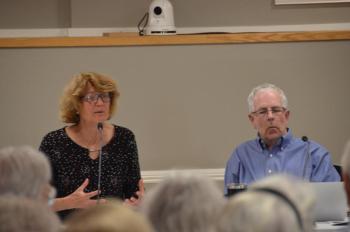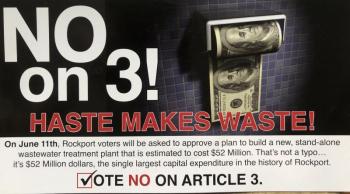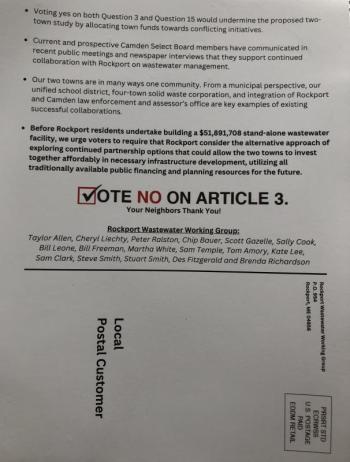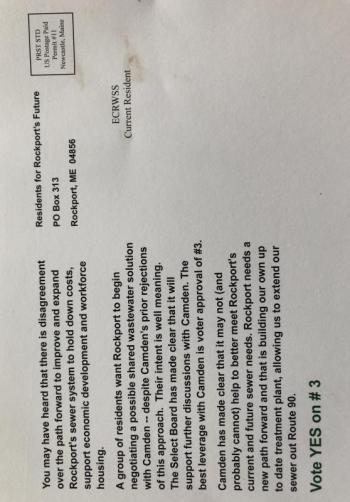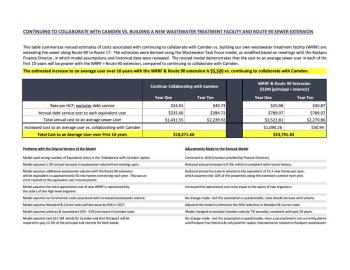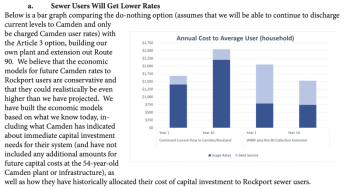Proposed Rockport wastewater treatment project drives robust citizen debate
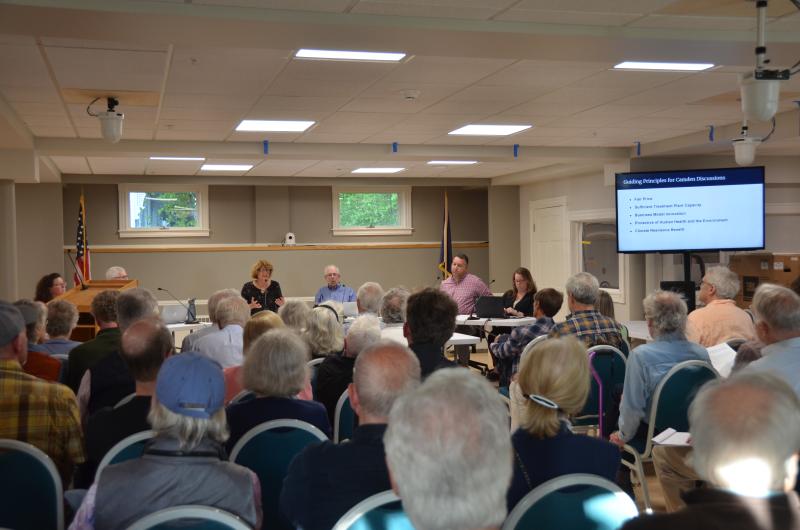
ROCKPORT — Article 3 on the Rockport Town Meeting 2024 warrant proposing a $33.7 million expenditure to build a new sewer facility has engendered political heat as voting day, June 11, approaches. Two distinct factions have circulated opposing advocacy mailers to town citizens, and one Camden resident has urged the Camden Select Board to reach out to Rockport to help resolve the issue.
The citizen led Rockport Wastewater Working Group, with a Rockport post office box number, sent a colorful mailer two weeks ago to citizens, declaring a “No on 3!, Haste Makes Waste,” message.
Another mailer from that mailbox, owned by the Rockport Wastewater Working Group, arrived June 7 in Rockport mailboxes.
The opponents to Warrant Article 3 argued that the proposed municipal plan to spend $33.7 million ($52 million with anticipated interest charges) is “the single largest capital expenditure in the history of Rockport,” and represents misinformed rationale and calculations on the part of the town.
They urge the town to place priority on collaborating with Camden to help fix the existing sewer system that Camden is struggling to upgrade.
On June 7, the group sent another mailer, again urging a no vote on Article 3 and summarized their positions in a Fact Sheet that lays out their interpretation of recent sewer history. And, they say that voting yes on Articles 3 and 15 would undermine the proposed two-town study by allocating town funds toward conflicting initiatives.
Residents for Rockport’s Future, on the other hand, have also advocated via the U.S. Postal Service with a mailer recommending a Vote Yes on Article 3, saying that while the opponents to the measure mean well, a yes on 3 would ensure Rockport has financial leverage moving forward with any Camden agreement.
Residents for Rockport’s Future, likewise, has a Rockport Post Office box number.
“Camden has made clear that it may not (and probably cannot) helps to better meet Rockport’s current and future sewer needs,” the mailer reads. “Rockport needs a new path forward and that is building our own up-to-date treatment plant, allowing us to extend sewer out Route 90.”
The debate has spilled over into Camden, where at the regularly scheduled June 4 Camden Select Board meeting, Camden resident Stuart Smith, who also owns extensive real estate in Rockport, including the new Rockport Harbor Hotel in the Village, took a turn at the podium during public comment period and advocated for collaboration between the two towns.
Smith said he has been working with a group (Wastewater Working Group) of 30 people for the last six months who want Rockport and Camden to overcome recent legal hostilities concerning how much Rockport pays to send sewage to Camden’s existing system. That issue, first surfacing in 2020, frayed the two-town inter-local agreement to the point the Rockport began exploring how to build its own stand-alone sewer system.
That initiative resulted in Article 3, a project sited on the Pen Bay Medical Center campus on a small piece of land that Rockport would purchase from MaineHealth. There, the town would build a sewer treatment plant and discharge treated effluent into Glen Cove oceanfront and eventually Penobscot Bay.
This proposed system would replace the current system of sending waste from Rockport Village, as well as a stretch along routes 90 and 1, to Camden’s treatment plant, before being discharged into Camden Harbor and out with the current and tides into Penobscot Bay.
Rockport’s wastewater from Route 1 south, Pen Bay Medical Center and the Glen Cove area is sent to the Rockland sewer treatment facility.
Speaking before the Camden Select Board, Smith suggested Camden and Rockport resume their historical collaboration. He said the system worked fine up until a new inter-local agreement (the current was set to expire after a 30-year run) became a contested topic and resulted in litigation between the two towns, which remains ongoing.
Smith asked the Camden Select Board, “to take a deep breath, take a step back, and say ‘yes, we want to talk about this.’”
He said, “Rockport says Camden has thrown them out,” adding that it is, “ludicrous to build a $35 million sewer plan four miles away when we have a perfectly good one here.”
Having funds generated by Rockport to help Camden upgrade its sewer system and plant would benefit the town, said Smith, describing Camden’s sewer problems (which earned violation notices from the Maine Dept. of Environmental Protection in 2015 and a consent agreement with the same agency in 2021 — Read: Camden’s six-year history of untreated sewage overflow goes before Maine BEP.
“Audra [Caler, Camden Town Manager] and Dave [St. Laurent, Camden Public Works Director] have stepped up and are doing a great job fixing those issues,” he said.
Smith wrote in an email to the Camden Select Board: “From my perspective as a Camden user and as a Camden taxpayer I would say that we have probably benefitted from working with Rockport as a ‘customer’ that is buying our services and that the revenue that is generated from this relationship must be helping to cover some portion of the operating costs for both the physical plant and its operations as well as a portion of the administration and oversight of the sewer treatment system.”
He continued, “It would be very helpful if the Camden Select Board, without making any commitment, to at least say that they are still willing to working together. This would go a long way in showing the voters in both Towns that Camden is not the obstacle in resolving this issue.”
Camden Select Board Chair Tom Hedstrom noted at the meeting that Smith’s sentiments had been expressed during public comment period, and being such, the topic was not on the agenda and no conversation about it would take place at that meeting.
While there was public outreach to Camden to make a move toward resuming talks, and although there is another citizen initiative warrant article before Rockport voters —- Article 15: “Do you favor requiring the Rockport Select Board to appoint an advisory committee to study the costs and benefits of a collaborative approach for improving wastewater treatment systems in the towns of Rockport and Camden, including a municipal utility district and to have such committee report findings to the Board prior to the 2025 Rockport Town Meeting and prior to funding the construction of a new wastewater treatment plant —- the public debate over whether Rockport should go it alone has only heightened in fervor, with more signs cropping up on lawns and intersections in town, and with letters to the editor.
The citizen-led Rockport Wastewater Working Group consists of Taylor Allen, Peter Ralston, Philip Conkling, Sally Cook, Cheryl Liechty, Chip Bauer, Bill Leone, Bill Freeman, Martha White, Sam Temple, Kate Lee, Sam Clark, Steve Smith, Stuart Smith, Des Fitzgerald, Brenda Richardson and Scott Gazelle.
They made the decision to send the Vote No on 3 mailer to Rockport residents, maintains its fundamental message: Haste makes waste.
The Residents for Rockport’s Future sent out the opposing mailer, Vote Yes on #3. They comprise 37 signatories of a letter to the editor, said Bill Bow, who was former chair of the municipally created ad hoc committee, the Rockport Wastewater Task Force. That task force crafted the current sewer treatment plan for Pen Bay Medical Center.
Residents for Rockport’s Future include Joan Welsh, Richard Remsen, Clay Tolman, Geoff Parker, Helen Shaw, Mark Kelley, Doug Cole, Leni S. Gronros, Betsy Elwin, Debra Hall, Bob Hall, Bill Bow, Nan Bow, Holly Boyd, Patricia Cole, Nick Ruffin, David Pio, Paula Coyne, Bob Lawrence, Bob Kollmar, Bill McClellan, David Bannister, Lynn Bannister, Josh Gerritsen, Laura Gerritsonl Michelle Gallant, David Pier, Karen Pier, Eric Pier, Vincent Pier, Tony Pinson, Kate Pinson, Harold McWilliams, Marilyn McWilliams, Anne Minnich, Todd Kirchgessner and Jeffrey Runge.
Citizens associated with both groups debated the merits and drawbacks of Article 3 at a May 28 meeting of the Wastewater Task Force, where four Rockport Select Board members also represented the town.
The meeting took place in the Geoffrey C. Parker Meeting Room of the Rockport Opera House and was streamed live.
The first portion of that meeting consisted of Select Board Chair Denise Munger and Bill Bow delivering municipal reasoning for supporting a yes vote on Article 3.
Main points they made included:
All Rockport citizens will benefit, and sewer users are eventually to get reduced rates, by Year 10, the town said, as represented in its financial model.
Rockport knows of housing development projects currently on hold because of the current sewer system issues.
Camden said it would not support Rockport’s sewer expansion along Route 90 to Route 17.
Camden has repeatedly asked Rockport to build its own treatment plant.
It is has been a frustrating five years trying to negotiate an agreement with Camden.
It is not a question of people not getting along, it’s really that Camden’s plant is over-capacity.
Debt will initially increase but then prices will be greatly reduced.
In 10 years, Rockport sewer users will see a $1,000 dollar reduction in fees, rates will go down, debt service will go up.
Camden rates are not going down.
Pen Bay Medical Center has talked with Bow about the possibility of using the effluent from Rockport processed wastewater for its HVAC system.
Pen Bay Medical Center uses 30,000 gallons a day, drawing from Maine Water’s system, Mirror Lake and Grassy Pond (both in Rockport). Rockport water users draw 100,000 gallons a day, said Bow.
By using the effluent, Pen Bay Medical Center could reduce the stress on Mirror Lake and Grassy Pond water supplies.
“That resource, from a resilience perspective, has to be preserved,” said Bow.
Camden told Rockport to get out, he said. Bow said he reached out to Camden, but no response.
He explained that Rockport sends 70,000 gallons of wastewater a day to Camden.
“Camden charges us for what is in the pipes when it crosses the town line,” he said. “That includes anything that leaks into the pipes.”
Camden’s pipes are falling apart and leaking like a sieve.
In total, Camden processes 425,000 gallos per day; of that 65,000 is from Rockport, and 65,000 is from Mid-Coast Solid Waste Transfer Station and a quarry that has to be pumped and diverted so its toxic waters do not enter Lily Pond.
“That pumping keeps the crud from flowing down into Lily Pond,” said Bow.
If Rockport builds a sewer system at Pen Bay Medical Center, the wastewater from the transfer station could be diverted to Rockport and possibly become a revenue stream for Rockport.
“They’ve got a mess on their hands,” said Bow, about Camden.
Camden has a 50 years-old plant. A $30 million investment to upgrade in Camden is not out of the question, he said. Plus, moving the discharge pipe further out into Camden Harbor, as requested by the DEP, could cost another $1 to $4 million, said Bow.
Having its own facility gives Rockport control, said Munger.
“A delay in the approving Article 3 will only increase costs to us,” she said.
She added that grant money is still available, but “a lot sunsets next year.” She advocated getting into the grant funding pipeline soon.
Bow said Camden is “not terribly enthused about” a municipal utility district.
Guiding principles for Camden discussions must include:
• Fair price
• Sufficient treatment plant capacity
• Business model innovation
• Protective of human health and the environment
- Climate resilience benefit
Rockport resident Jan Rosenbaum asked for clarification on the waste that is sent from Pen Bay Medical Center to Rockland.
Bow said that a third of Rockport’s wastewater goes to Rockland. Pen Bay Medical Center has to store it during the day and then send it along to Rockland at night to avoid overloading Rockland’s treatment facility.
Pen Bay Medical Center has a storage capacity of 24 hours, said Bow.
Rockport resident Brinkley Thorne expressed support for building a new facility for Rockport’s sake, and asked what Camden will have to spend to fix its problems.
Camden has a $50 million problem, responded Bow.
He said the proposed site at Pen Bay is on the Clam Cove (Glen Cove) side of the medical campus owned by the Portland-based nonprofit MaineHealth.
The wastewater from the hospital currently goes into an existing 50,000-gallon holding tank. Prior to hooking into the Rockland wastewater treatment facility, the hospital used to treat its own wastewater and then discharge effluent into Clam Cove. Now, the waste is kept in the existing tank and the hospital is required to aerate 25,000-30,000 gallons all day.
When Rockport’s Wastewater Task Force first began talking with Pen Bay, Rockport asked about using the existing footprint on the medical campus.
Pen Bay Medical Center indicated it would sell the footprint to the Town of Rockport, as well as an easement to the shore, Bow said.
That cost, although not defined, is bundled into the proposed $33.7 million expenditure.
The draft design entails running a pipe 15 feet beyond mean low tide, but because it is shallow in that spot, the pipe may have to extend further into the Cove.
The effluent would be, “clear, clean water,” said Bow.
Rockport resident Scott Gazelle disputed the financial model used by the town, saying there are, “a number of errors in the model and assumptions that are unjustifiable.”
According to his modeling, the increase in cost over the first 10 years is over $5,500 to an average sewer user, said Gazelle.
He produced his own modeling (See image), which included the conclusion: “The revised model demonstrates that the cost to an average sewer user in each of the first 10 years will be greater with the WRRF plus Route 90 extension, compared to continuing to collaborate with Camden.”
Gazelle said the financial model as generated by the town, “is unstable” and Rockport is, “asking the voters to vote on false information.”
Rockport Finance Director Megan Brackett countered, saying that Camden changed the fiscal model, “whereby debt is built into rate, essentially it has inflated the rate, so we are paying 100 percent.”
Bow said new housing would further reduce ratepayer costs.
Richard Aroneau, of Camden, is partnering with Richard Remsen, of Rockport, to build a planned village in West Rockport known as Ingraham Corner.
“We are committed to try to create workforce housing on that site,” he said. “If there is anything we haven’t been hasty about in this community is building workforce housing.”
Aronneau said Remsen and he had been working for decades to make the planned development work. That development relies on the extension of a sewer line along Route 90 to the intersection of Route 17.
Vote yes on 3 and 15, said Aroneau.
One woman was concerned about the health of Penobscot Bay with two towns potentially discharging into its waters.
Bow said: “With us building our own facility, our water would be clean, but until Camden does something to bring its plant up to present day standards, they would still have the issues.”
Bow also mentioned that Rockport’s planning office is investigating further extension of sewer lines beyond Route 90, as well as an extension to the Penobscot Bay Area YMCA and the Midcoast Solid Waste transfer station and landfill.
Rockport resident Cheryl Liechty said the town’s newsletter, Rockport Resource, delivered a marketing pitch in favor of Article 3, which surprised her.
The resulting impression, she said, is the town saying, ‘don’t worry only a minority of households will be paying for this.’
The Rockport Resource said: “Only sewer users will pay for the bond; property taxes will not increase. This bond will be paid for by generous federal grants and revenue from our sewer users and is not part of the town’s budget that is paid for property taxes….”
Liechty said she was surprised, “that should be something we should be proud of.”
She said schools and municipal buildings, owned by taxpayers, would be using the sewer system, which means all taxpayers would have a stake in the new sewer plant project.
Furthermore, she said there is tax increment financing (TIF) money, “packed into this; that is all taxpayer money.”
“It appears that the town is not being transparent,” said Liechty.
Munger said no attempt on the part of the town had been made to mislead the public.
Martha White, Rockport resident, said she was in favor of more workforce housing and Ingraham Corner, “but that TIF is going be shared by every taxpayer in Rockport. To have the TIF is premised on increase in property taxes. You cannot do these developments without an increase in property taxes.”
White asked the town how many outstanding sewer bills were on the books as of May 28.
Brackett said 15, and several outstanding liens.
White questioned whether the town’s financial model for a Route 90 sewer extension included the potential for unpaid bills and liens.
And, she said, some residents were building new sewer systems along Route 90 now. What would happen to them, she asked, if the sewer line is extended and they would be forced to pay as the line passes in front of their property.
Taylor Allen said Camden had recently spent $15 million upgrading its sewage treatment plant, “to the point it is working well.”
Furthermore, he said that Camden is serious about tending to its infiltration issue, and solving its sewer system problems.
“I don’t think it is fair to blame Camden,” he said.
Rockport resident Betsy Elwin said Rockport’s construction of its own treatment plan could eventually be part of a larger system tying Camden, Rockport and Rockland together.
“We would be building a modern plant to be used for Rockport growth,” she said.
Munger said if Article 15 passes, Rockport will, “honor what our voters want.” But, she added, “that doesn’t mean we won’t be moving ahead with Article 3.”
Rockport resident Marti Stone asked what percentage of the project would be covered by grants.
Rockport Town Manager Jon Duke said there might be $3 to $4 million in grant funding.
He spoke of the strategic balance between pursuing grants ahead of gaining voter approval.
“Those who fund want to see the community behind it,” said Duke.
The town needs to speak with one voice in order to be successful in obtaining grants.
If both Article 3 and Article 15 pass, “we are going to keep moving forward in developing 3, with a report next year,” said Duke.
Any new interlocal agreement with Camden would go before voters on a town meeting warrant; likewise with a utility district, said Duke.
Rockport resident Joan Welsh said the purpose of Article 3 is to help Rockport residents with its sewer payments, “and make them as minimal as possible.”
The goal is to assure a good system for the wastewater to pass through into the ocean, and establish, “leverage for us so Camden knows we are serious and we need an answer from them,” she said.
Rockport resident Sam Temple, co-owner of Rockport Marine, said a sewer extension and new housing developments are, “going to drive home prices up and taxes up,” he said.
He said Article 3 is not going to get the attention of Camden and that Rockport received much negative attention by, “underpaying our bill.”
Munger said Rockport, “paid up last September and they have not acknowledged that.”
While Munger and Temple debated whether Rockport continued to underpay Camden, Town Manager Jon Duke interjected, laying out the directives from Camden in a 2022 letter to Rockport serving, “as commencement of a four-year notice recognizing the fact of the expiration of the Feb. 26, 1990 interlocal sewer agreement between Camden and Rockport.”
Duke said that 2022 letter was the last correspondence of official dialog concerning sewer policy.
“I understand there are individual conversations that seem to be happening all over this matter,” said Duke.
Some have been, “fruitful and interesting, no doubt,” said Duke.
“The problem is that these guiding principles for Camden, which have not been voted on by the board or approved by the town, but those are underlying principles that have guided the five years of the prior Select Board that discussed this, the current Select and future Select Boards. And though there is a willingness to discuss conversation, the difficulty is that when you get through these bullets, is that the conversation dries up.
“That is the way this conversation has been for the last three years, and seemingly for the two years before that. This is a last chance scenario. I don’t think anyone on this table [Select Board, Bow, Duke and Brackett], and I don’t think anyone in the audience wants to be here having this conversation about wastewater. I don’t.
“The amount of time not working to help Richard on workforce housing to West Rockport, or Brink and Masie [two Rockport residents also considering building a housing development in the Village], and some of these others who have talked with us about this…. We have spent an incredible amount of time trying to get to the table to talk about about it. And that is a sad state of affairs that two communities can’t have a conversation about it…. But I think what we have proposed ourselves with, as a community, is an option that could work. As voters, you all will decide if that is the right decision or not.”
Temple replied: “I do think you have come up with a great plan for a stand-alone system if we have to stand alone. I think it is sad that the two towns have not been able to do it. There is a group in town, that I am a part of, that is saying, maybe the right people are not talking, and that’s the intent of the citizens’ initiative, to say let’s put a different group of people together who will act rationally, we think.”
Temple said his statement was not a slight on the current Select Board.
“We’re saying it does not make any sense,” said Temple. “Let’s figure it out so that it does.”
Reach Editorial Director Lynda Clancy at lyndaclancy@penbaypilot.com; 207-706-6657


